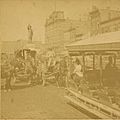Monuments relating to the Haymarket affair facts for kids
The Haymarket affair was a very important event in Chicago's history. It happened in 1886 and involved workers, police, and a bomb. This event changed how people thought about workers' rights and led to the creation of May Day. To remember what happened, several monuments were built. They help us learn about this important time.
Contents
Haymarket Square: The Police Monument
In 1889, a large bronze statue of a Chicago policeman was put up in Haymarket Square. A sculptor named Johannes Gelert made it. People raised money to build this statue. It was meant to honor the police involved in the Haymarket affair.
Over the years, the statue moved several times. In 1927, a streetcar crashed into it! The driver said he was "sick of seeing that policeman." The city fixed the statue and moved it to Union Park. Later, when a big highway was built, the statue moved again. It ended up overlooking the freeway near its first spot.
The statue was damaged many times. In 1968, someone painted it black after a protest. Then, in 1969, a group called Weatherman blew it up with a bomb. The explosion broke many windows nearby. The statue was rebuilt, but Weatherman blew it up again in 1970!
After that, the city rebuilt the statue once more. Mayor Richard J. Daley even had police guard it 24 hours a day. This guard was very expensive. In 1972, the statue was moved inside the Central Police Headquarters. Later, it moved to the Chicago police academy. For a long time, only its empty base was left in Haymarket Square. This base became known as a landmark for people who believed in anarchist ideas. In 2007, the statue was put back on display at the Chicago Police Headquarters with a new base.
In 1992, a bronze plaque was placed on the sidewalk in Haymarket Square. It marks the spot where speakers stood during the rally. The plaque explains that the event led to the "tragic death of both workers and policemen." It also says the event brought worldwide attention to the labor movement. It helped start the tradition of 'May Day' labor rallies in many cities.
More Photos of the Police Monument
Haymarket Martyrs' Monument
After the Haymarket affair, some of the people involved were put on trial. Five of them—George Engel, Adolph Fischer, Louis Lingg, Albert Parsons, and August Spies—were buried in a cemetery near Chicago. Later, two other people from the trial, Oscar Neebe and Michael Schwab, were also buried there.
In 1893, a special monument was built for them. It is called the Haymarket Martyrs' Monument. A sculptor named Albert Weinert created it. The monument is 16 feet tall. It has a tall granite shaft with a carved stone on top. At the bottom, there is a bronze statue of a woman standing over a fallen worker.
The monument was dedicated on June 25, 1893. Many people marched from Chicago to attend the ceremony. On the steps, it says "1887," which was the year the men died. There is also a famous quote from August Spies. He said, "The day will come when our silence will be more powerful than the voice you are throttling today." This means that even after they were gone, their message would still be strong.
The back of the monument lists the names of the men. It also has text from a pardon given later by Illinois governor John Peter Altgeld. This pardon said that the men had not received a fair trial.
About 8,000 people came to the dedication. Unions and other groups sent flowers. In 1997, the Haymarket Martyrs' Monument was named a National Historic Landmark. This means it is a very important historical site in the United States.
Mary Brogger Monument
On September 14, 2004, a new monument was revealed in Chicago. It was made by artist Mary Brogger. This monument is a fifteen-foot sculpture of a speakers' wagon. It looks like the wagon that labor leaders stood on in Haymarket Square. They used the wagon to talk about the idea of an eight-hour workday.
This bronze sculpture is meant to represent the rally at Haymarket. It also stands for free speech. The plan was for this sculpture to be the main part of a new "Labor Park." This park would also have a wall to remember international events, sidewalk plaques, and other features. However, the park has not been built yet.
Images for kids










